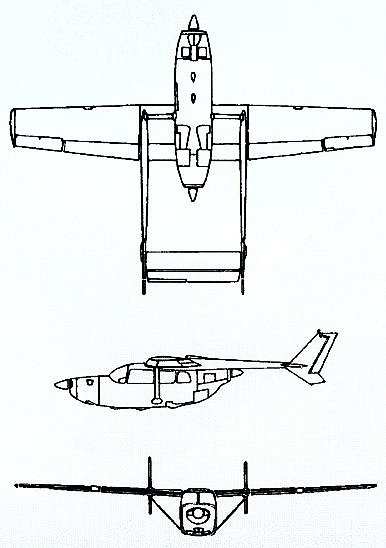Attorneys Argued That Skymaster Was Improperly Maintained,
Leading To The Crash
One of the largest verdicts resulting from an airplane accident
was handed down on December 14 by a Philadelphia jury. Dr. Robert
Marisco Jr. and his fiancee Heather Moran, both of Akron, Ohio,
were awarded $11.35 million in compensatory damages in an action
against Winner Aviation Corporation, a repair facility based at
Youngstown-Warren Regional Airport in Ohio.

Dr. Marisco, a dermatologic surgeon, and Ms. Moran, the pilot,
were flying back to Ohio in Dr. Marsico's Cessna 337 when it
developed an engine problems and went down about 10 miles from
DeKalb-Peachtree Airport in Georgia on Aug. 8, 2007. A post-crash
fire ensued. Dr. Marisco and Ms. Moran both suffered multiple
injuries, including third degree burns covering nearly 40 percent
of their bodies.
The NTSB notes in its probable cause report that "the pilot, age
34, held a commercial pilot certificate with airplane single engine
land, multi engine land, and instrument airplane ratings, and a
CL-65 rating with "SIC privileges only." The pilot reported 4,650
hours of total flight time, with 145 hours in make and model. Her
latest FAA first class medical certificate was issued on June 5,
2007."
At trial, attorneys for the plaintiffs said Dr. Marsico's Skymaster
had been maintained by Winner Aviation prior to his acquisition of
the aircraft, and he continued that relationship after he purchased
it in 2006. According to the attorneys, from 2006 until the time of
the crash, the Skymaster had reportedly experienced recurrent
problems with its rear engine. Winner Aviation performed repeated
troubleshooting on a waste gate. On the day of the crash, the rear
engine on the twin-engine airplane lost power after takeoff, and
attempts to restart it failed. Ms. Moran was unable to maintain
altitude and attempted an emergency landing. A post-crash fire
ensued.
At trial, plaintiffs claimed, among other things, that Winner
Aviation did not maintain the aircraft in an "airworthy condition."
Plaintiffs further alleged that Winner Aviation's misdiagnosis of
the recurrent problems of "power loss" in the rear engine was
compounded by an alleged failure to have an appropriate inspector
investigate all work that was being performed by its mechanics.
Plaintiffs also alleged that Winner Aviation was aware that the
front engine was long overdue for a complete overhaul, but did not
recommend an overhaul to Dr. Marsico. Plaintiffs argued at trial
that the failure to overhaul this engine or, at the very least,
perform a proper inspection and repair of its valve guides and
other engine parts, caused a diminution of power during an
in-flight emergency—precisely when full power was most
important.

The NTSB probable cause report, which is not admissible as
evidence in court, confirmed the engine failure but placed the
responsibility for the accident with the pilot. According to the
report, "Shortly after takeoff on a hot day, after the airplane was
about 10 miles from the departure airport, the rear engine failed
for undetermined reasons. The pilot turned the airplane back toward
the airport, feathered the rear engine, and maintained front engine
power at the top of the green arc of the manifold pressure gage, at
33 inches of manifold pressure. The airplane did not maintain
altitude at that power setting, and to avoid houses and vehicles on
the ground, the pilot performed a forced landing at a water
treatment plant. During the landing, the airplane struck the top of
a concrete structure, hit the ground, and became engulfed in
flames. According to the owner’s manual, after an engine
failure, the remaining engine power to be used is to be "increased
as required." The published maximum power setting was 37 inches of
manifold pressure at "red line," without any time limitations. A
performance calculation indicated that at the existing ambient
temperatures, and at that power setting, the airplane should have
climbed at least 290 feet per minute. Additional references to the
use of a 37-inch power setting, including performance calculations,
were noted in the owner’s manual."
The report also states that "At the time of the engine failure,
the pilot estimated the airplane was 1,000 to 1,500 feet above the
ground, and between 2,700 feet and 3,000 feet above mean sea level
(msl). GPS indicated a small airport about 6 miles away, but the
pilot felt the larger airport they had just departed, about 10
miles to the south, would be better due to emergency equipment and
a control tower. The pilot then began a gradual turn back toward
the south, and while doing so, asked the passenger to verify rear
engine switch positions. She then attempted an engine restart, and
when it was unsuccessful, she contacted DeKalb-Peachtree Tower and
advised the controller of the situation."
The National Transportation Safety Board determines the probable
cause(s) of this accident to be the "pilot’s failure to
utilize all of the power available following an engine failure.
Contributing to the accident were the failure of the rear engine
for undetermined reasons."
 ANN's Daily Aero-Linx (04.13.24)
ANN's Daily Aero-Linx (04.13.24) ANN's Daily Aero-Term (04.13.24): Beyond Visual Line Of Sight (BVLOS)
ANN's Daily Aero-Term (04.13.24): Beyond Visual Line Of Sight (BVLOS) Airborne 04.09.24: SnF24!, Piper-DeltaHawk!, Fisher Update, Junkers
Airborne 04.09.24: SnF24!, Piper-DeltaHawk!, Fisher Update, Junkers Aero-News: Quote of the Day (04.14.24)
Aero-News: Quote of the Day (04.14.24) ANN's Daily Aero-Term (04.14.24): Maximum Authorized Altitude
ANN's Daily Aero-Term (04.14.24): Maximum Authorized Altitude




